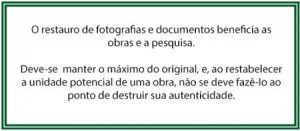BIBLIASPA brings you the possibility of intervening in a work or a collection, in any scope, be it paper (photographs, books, maps and documents, such as passports, certificates etc.), sculpture, painting, furniture, metals, through partnerships With restorers.
If you need to restore some work, contact us.
We work within the principles of the restoration of minimal intervention, with materials that are mostly reversible and that will not remove the legitimacy and historical, artistic and aesthetic value of the work, as well as the affective and financial value.
Mechanical cleaning with soft brush
Importance of restoration
Restoration is the preservation of public or private property. The smaller the intervention, the greater the authenticity of the work.
The restoration seeks to minimize the impact on the originality of the work, with the care of using reversible materials. Before the need for restoration intervention, it is possible to adopt precautionary measures, what we call preventive conservation.
We follow the basic principles of restoration dictated by the Italian restaurateur Cesari Brandi, who in Theory of Restoration gives us some indications:
Restoration is “any intervention intended to restore efficiency to a product of human activity” (BRANDI: 1963).
“Restoration constitutes the methodological moment of recognition of the work in its physical consistency and in its twofold aesthetic and historical polarity, with a view to its transmission to the future” (BRANDI: 1963).
Preventive conservation
Every work has a useful life. Thus, you need special care, such as:
– storage (if the work is often transported);
– relative humidity and temperature controlled;
– exposure to the sun (morning and evening) or with artificial lighting;
– adequate ventilation at the site where the work is located.
We often believe that the use of air conditioning contributes to the safeguarding of a building site, but we forget to use deodorizers in some environments with very high relative humidity.
Applying the concept of preventive conservation, every work survives time in its original form.
Methodology of intervention in a work
Intervention.
- All the works that are delivered to BIBLIASPA are cataloged in an inventory card of the work, with all possible history inherent to the work, as well as photographs taken before, during and after the intervention that can be done. The same happens with the works that are donated to our institution;
- We proceed to the mechanical cleaning of the work to remove superficial or deeper soils. If it is really necessary, we will do a cleaning with chemical agents that do not damage the work;
- The reintegration should be easily recognizable, with reversible materials, but without breaking with the unit to be reconstructed (proportional to the distance of the observer);
- Matter is irreplaceable only when it collaborates directly in the figuration of the image;
- Future interventions should not be prevented; On the contrary, they should be facilitated.
Postulates of restoration
First postulate of the restoration:
“Only the material form of the work of art is restored”
Second postulate of the restoration:
“The restoration must aim at restoring the potential unity of the work of art, as far as possible, without producing a historical or artistic falsification and without erasing every trace of the passage of time left in the work of art.” Cesari Brandi argues that the restored object does not return to the moment of creation, but continues to bear the marks of time, respecting temporality and its original conformation.”
“The restoration of photographs and documents benefits works and research.
The maximum of the original must be maintained and, in restoring the potential unity of a work, one should not do so to the point of destroying its authenticity.”
Here are some examples of procedures for restoring:
Differentiation of areas added with restoration procedures.
Terracotta sculpture, representing Saint John the Baptist boy. Portuguese sculpture based on cork, late 19th / early 20th century, belonging to a private collection
Fig. 1 – The work in the state in which it was before the restoration. Initially, it underwent a process of mechanical cleaning with soft brush, for dust removal and cobwebs.
Fig. 2 – With the use of the scalpel, we remove as deeper dirt, such as insect waste
Fig. 3, 4 and 5 – Fill gaps with modolstuc (fill mass) attached to rabbit glue. The gaps were noticed after we removed the damaged head, and others were noticed only after the removal of lacquer
Fig. 6 – Chemical cleaning with ethyl alcohol to remove the layer of oxidized shellac
Fig. 7, 8, 9 and 10 – Using a scalpel, we gouged the lacquer gum, which was also attached to the base in terracotta, giving a dark green tone that would match the color tone given to the surface of the cork applied to serve as a base
Fig. 11 – Work after the intervention, with reversible materials such as watercolors, fillers and paraloid B-72, used as final varnish














